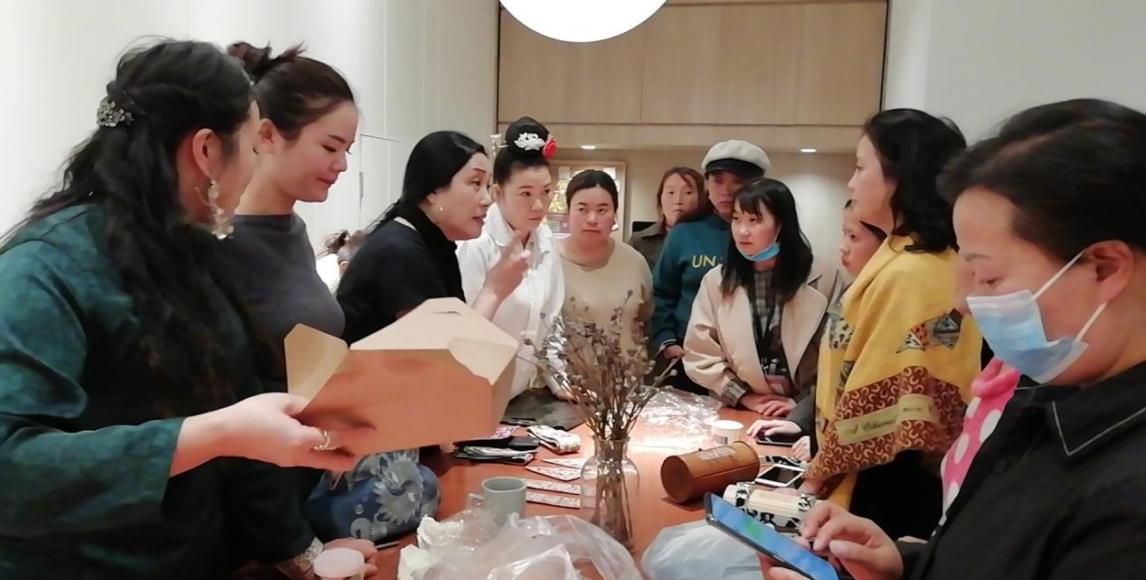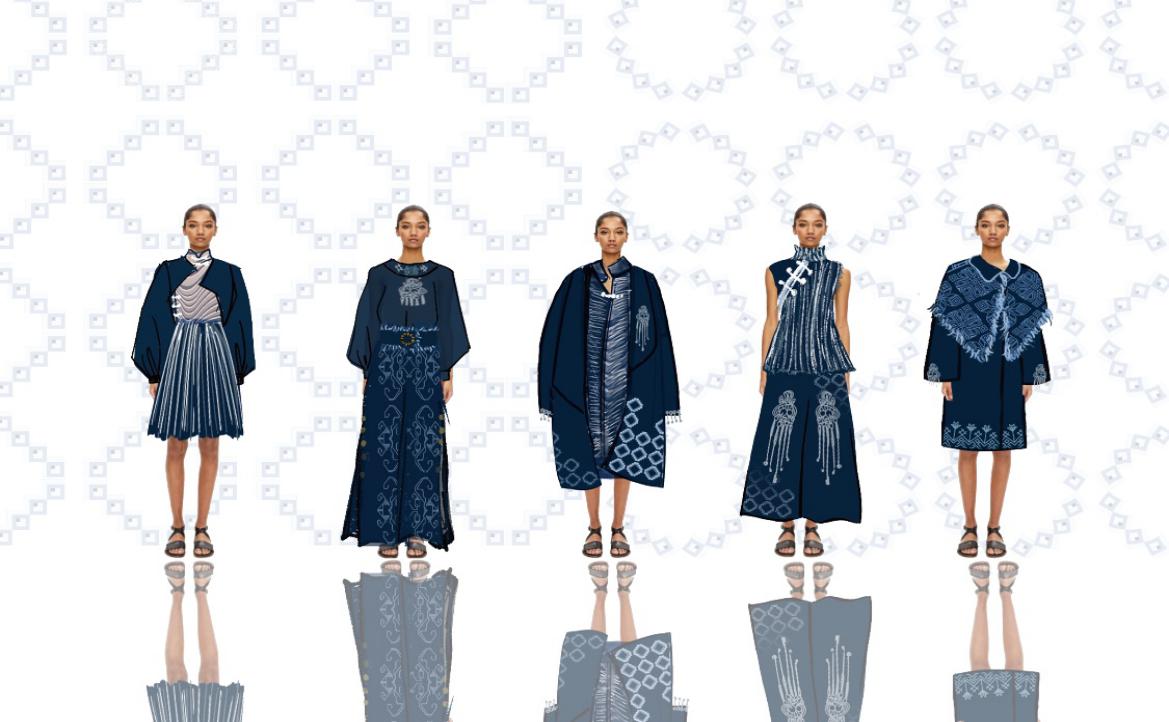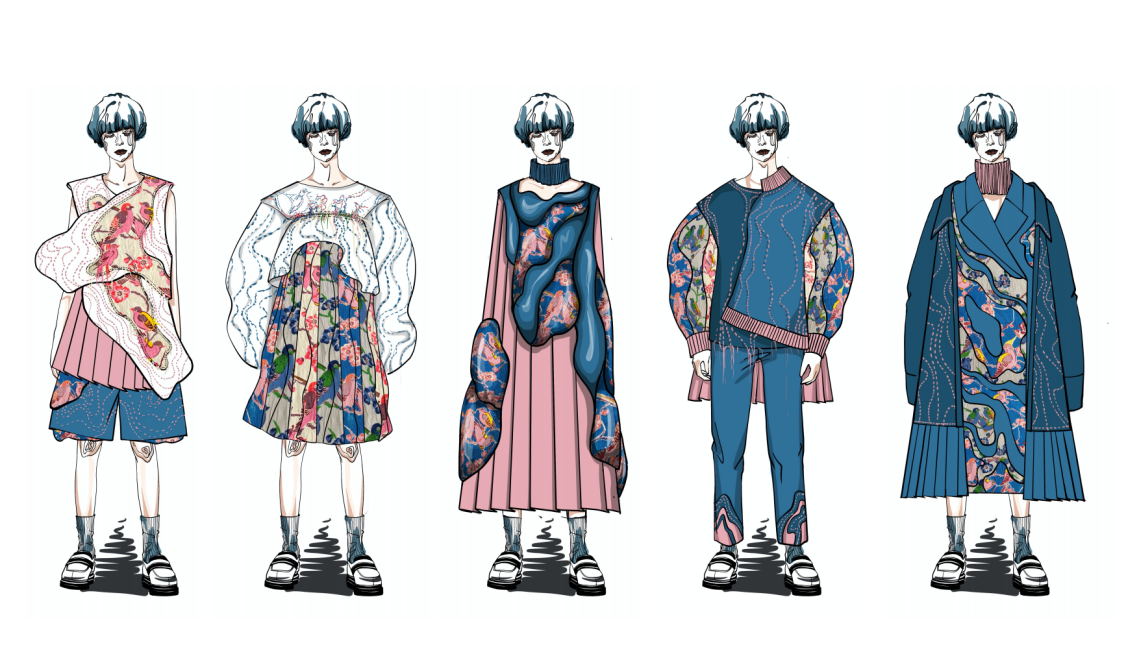The innovative national costumes designed by excellent trainees have been highly acclaimed; scholars answered how intangible cultural heritage research should take root and blossom in the internationalized Shanghai; the fashion show based on traditional embroidery creativity and fashion design drew praise...a series of activities for the closing of the 8th Intangible Cultural Heritage Training Class of DHU which lasted four days came to an end. Attendees included Xiang Zhaolun, former vice-minister of the Ministry of Culture and Tourism, Wu Jincheng, director of the Shanghai Municipal Commission of Economy and Informatization, Wang Lan, deputy secretary and mayor of Changning District, Shanghai, Sun Huaibin, vice-chairman of the China Textile Industry Federation, Liu Boying, deputy director of the Office of Shanghai Cultural and Creative Industry Promotion Leadership Group, Wang Juan, a first-level investigator of the Intangible Cultural Heritage Division of the Guizhou Provincial Department of Culture and Tourism, and Hu Entong, director of the Intangible Cultural Heritage Division of the Shanghai Municipal Bureau of Culture and Tourism. The school leaders presented at the activities included Party Secretary Liu Chenggong, President Yu Jianyong, Deputy Party Secretary Liu Shuhui, Cui Yunhua, and Wang Yunjun, and Vice Presidents Qiu Gao and Chen Ge.
The works by excellent trainees show fashionable Guizhou style
This training class was characterized by “Elites returning, providing precise assistance”. After more than a month of intensive research and study, 12 outstanding trainees from previous training classes and 8 students from Zunyi, Guizhou, who were assisted by Shanghai counterparts, had gained satisfied achievements. At the Fashionable Guizhou Style - Static Exhibition of the Achievements from the Eighth Intangible Cultural Heritage Research and Training Class, opened on November 19, more than 100 innovative design works by 20 trainees were dazzling, including traditional ethnic costumes of Guizhou, and embroidery products and intangible cultural and creative products designed and produced during the training period or in Guizhou. The embroidery-related intangible cultural heritage inheritors of Miao, Buyi, Gelao and other ethnic groups from Guizhou demonstrated their skills through the university research and training platform. Through the training, trainees mastered the skills required for the whole process of garment making starting from fabrics selection. In addition, the training inspired many quick learners to produce several sets of innovative ethnic costumes that could be put into the market.

(Site of the training class)
The copper sheets and tassels made the two-piece ethnic costumes that were somewhat “old-fashioned” suddenly more dynamic. From the teacher’s point of view, Wei Houzhen, a fashion designer and producer, is an outstanding student who has an inquiring mind. As a trainee of the fifth training class, she eagerly acquired knowledge in her “returning” training. In addition to traditional ethnic costumes, she also used different fabrics and craftsmanship to make 4 sets of pillows. “From the design of the first draft to making the ready-made garment, this is the first time I have completed the entire production process independently. DHU teachers taught me patiently and inspired me to make innovations and improvements,” said Wei Houzhen, full of sense of contentment and happiness when talking about the training. Pieces of static works let viewers feel that the national craftsmanship rooted in excellent traditional culture is reborn and goes international through the innovative design.
When intangible cultural heritage meets internationalization
In the new era, how can intangible cultural heritage safeguarding be based on the original, absorb external elements, and face the future? On the morning of November 22, the “Original·External·Future: Shanghai Intangible Cultural Heritage Research from an International Perspective” - the 8th Intangible Cultural Heritage Research Academic Forum of DHU opened. The forum was divided into three sections: the launching ceremony of the book Shanghai Woolen Embroidery Research, the general forum and the sub-forums, bringing together experts and scholars inside and outside the University, industry elites and inheritors. Chen Qinjian, the tenured professor of East China Normal University, the former review expert of the intangible cultural heritage project of the Ministry of Culture and Tourism, and the former vice chairman of the Chinese Folklore Society, believed that there are so much cultural heritage with a blend of Chinese and Western cultures in Shanghai, which are eye-catching, and the intangible cultural traits endow this city with a unique spirit and cultural personality. Li Shoubai, the vice chairman of the Shanghai Federation of Literary and Art Circles, the chairman of the Shanghai Civic Artists Association, and an inheritor of the Shanghai style paper-cutting technique, said that it is the responsibility of intangible cultural heritage inheritors to adhere to the traditional culture and achieve both inheritance and innovative development. We could deliver unique works only through redesigning and recreating.

(Site of the Forum)
“Internationalization” is one of Shanghai’s geo-cultural characteristics, as well as one of the discipline characteristics of the Design Department of DHU. Shanghai Woolen Embroidery can be an indication of the international characteristics of geo-cultural culture, which is originated from the West but has survived and thrived in Shanghai, eventually becoming a national intangible cultural heritage. At the release ceremony of the new book Shanghai Woolen Embroidery Research published by the Donghua University Press, young students presented flowers to the intangible cultural heritage inheritors, showing their respect.
In recent years, DHU has given full play to the role of “research and training university”, concentrated efforts on research and training, and closely integrated intangible cultural heritage research and training with academic research and student training. It has discovered and cultivated higher-level young talents for intangible cultural heritage inheritance and driven the design discipline to integrate into the world and lay particular stress on fashion, while being more deeply rooted in Chinese excellent culture. Professor Ke Ling, director of the Intangible Cultural Heritage Education Research Center of DHU, said that one of the purposes of holding the forum is to give scholars and students in Shanghai the opportunities to conduct academic exchanges and trying, and encourage graduate students to not merely obey what the big names say, but also have courage and confidence to conduct independent research and active communication.
A much-told story about inheritance and development
“Ethnic culture and fashion, tradition and innovation, contradiction and integration, seem to be non-matched but closely connected. I hope to build a bridge for them, and become a disseminator and innovator of Miao embroidery culture.” Trainee Xiong Kuanyan, a minority embroiderer from Guizhou, said excitedly. On the afternoon of the 22nd, 40 sets of fashions designed by the inheritor trainees and 10 graduate students majoring in Fashion Design of DHU in pairs appeared brilliantly at the dynamic show of the Achievements from the 8th Intangible Cultural Heritage Research and Training Class. Students, designers and intangible cultural heritage trainees jointly created a costume feast, telling a much-told story about inheritance and development.


(Site of the dynamic show)
The dermatoglyphic pattern of Miao possesses a high degree of aesthetic value and aesthetic taste after thousands of years of historical and cultural accumulation. On the Runway, the “Meaning of Miao” series of costumes jointly designed and produced by Xu Junyi, a second-year graduate student majoring in Art Design, and intangible cultural heritage inheritors Huang Xianmei, Tian Mengqin, and Feng Shisu were eye-catching. “Meaning of Miao” was inspired by the patterns of the Miao fans and silver ornaments. The inheritors and graduate students jointly designed the silver ornaments of Miao, combining traditional craftsmanship with modern technology to explore more possibilities. The representative patterns of Miao, such as the octagonal pattern and the butterfly mother, were presented on the fabric through the use of laser surface treatment technology, combined with the decorative designs presented by techniques such as cross stitch and seeding embroidery, which provided the patterns with layers. On the basis of laser marking, the silver ornament pattern embroidery was completed by technology such as chain stitch, supplemented by silver ornaments, retaining the agility of silver ornaments.

(Design drawings of the “Meaning of Miao” series of costumes)
The red-dominated “Look Very Happy” series of costumes broke the inflexible impression that Miao people like to wear costumes that are mainly in blue, black, and white. The work was inspired by the legend of the “butterfly mother” of Miao in Southeast Guizhou, and it was completed by a second-year graduate student Zhao Yige and the inheritors Shi Liusha, Li Fang, and Jin Hui. The patterns of Miao such as butterfly mothers, flowers, and birds were embroidered on the printed fabrics by use of chain stitch, plain embroidery and other techniques, enhancing the three-dimensional sense of the costumes.

(Design drawings of the “Look Very Happy” series of costumes)

(Show of the “Look Very Happy” series of costumes)
As one of the first batch of designated research and training universities in the “Research and Training Program of Chinese Intangible Cultural Heritage Inheritors”, DHU has conducted 8 intangible cultural heritage training classes on the “Creative Design of Traditional Embroidery” based in Guizhou and Yunnan in the past four years. A total of 191 inheritors have participated in the training of embroidery, and 78 intangible cultural heritage-related managerial staff and teachers have been trained. Moreover, 25 dynamic shows and static exhibitions about the research and training achievements have been held, and more than 1200 sets of works have been exhibited. DHU’s intangible cultural heritage research and training achievements went international many times, and appeared at the China International Import Expo, the Outstanding Achievements Exhibition of China’s Intangible Cultural Heritage Research and Training etc., demonstrating cultural confidence. Besides, it vigorously develop design disciplines through intangible cultural heritage research and training, and assists educational poverty alleviation, which reflects the responsibility of research and training universities.


